Age of Satavahanas | SSC CGL Tier 2 - Study Material, Online Tests, Previous Year PDF Download
Satavahanas Dynasty

The Satavahanas
- In the Deccan, the Satavahanas established their independent rule after the decline of the Mauryas.
- Their rule lasted for about 450 years.
- They were also known as the Andhras.
- The Puranas and inscriptions remain important sources for the history of Satavahanas.
- Among the inscriptions, the Nasik and Naneghat inscriptions throw much light on the reign of Gautamiputra Satakarni.
 Naneghat Inscriptions from 2nd Century BCE
Naneghat Inscriptions from 2nd Century BCE
- The coins issued by the Satavahanas are also helpful in knowing the economic conditions of that period.
- The founder of the Satavahana dynasty was Simuka.
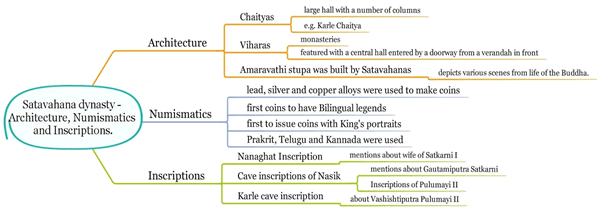
Identity of Satavahanas
- The Pauranic genealogies refer to the kings of 'Andhra-Jati'. Some Puranas style them as Andhrabhrityas.
- The Nanaghat and Nasik cave inscriptions and coins discovered in the Deccan mention the names of several kings of 'Satavahana-Kula'.
- On the basis of certain names, and their order of succession common to various kings mentioned in the two sources, some scholars identified the Satavahanas of the epigraphical records and coins with the Andhras of the Puranas.
- However, the Puranas never use the term 'Satavahana' and the inscriptions and coins do not refer to the Satavahanas as the Andhras.
- According to R.G. Bhandarkar, The Andhrabhritya dynasty of the Puranas is the same as the Satavahana dynasty of the inscriptions'.
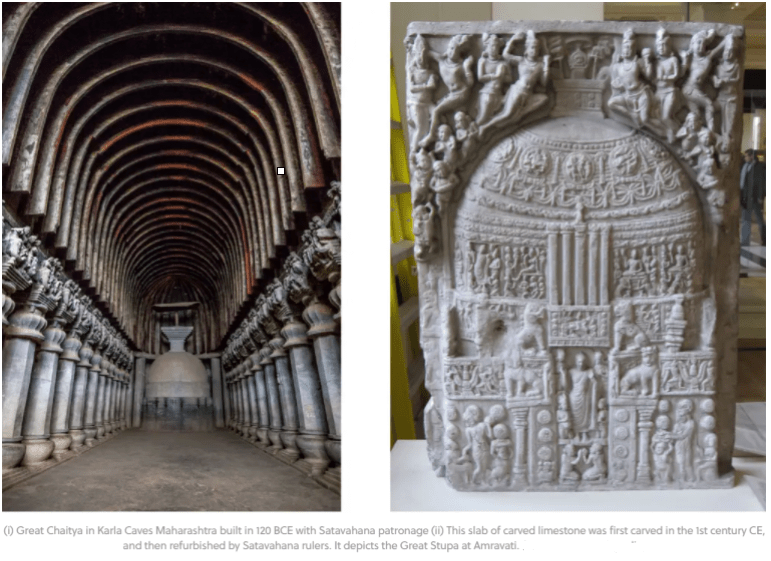
Political History of the Satavahanas
- The vague, disputed and uncorroborated doubtful evidence form the basis for the history of the Satavahanas.
- The Jain sources mention Satavahana as the first king in the family. The Kathasaritsagara also contains a story about Satavahana.
- The Kondapur coins bear the legend 'Sadvahana'. On scriptural grounds, this Satavahana is placed close to (either before or contemporaneous with) Simuka, the first ruler of the family mentioned in the Puranas.
- The latest discovery, Kotilingala coins (from Karimnagar district) included seven coins belonging to this Simuka.
- The legend on these coins strengthens the possibility that the king Satavahana of Kondapur coins is none other than Simuka himself who is called Simuka Satavahana in a Nanaghat label inscription also.
- It may be assumed that Simuka Satavahana was the founder of the dynasty and his successors called themselves Satavahanas.
Important Rulers of Satavahana


Simuka
- Considered to be the founder of the Satavahana dynasty and was immediately active after Ashoka’s death.
- Built Jain and Buddhist temples.
Satakarni I (70- 60 BC)
- Satakarni I was the 3rd king of the Satavahanas.
- Satakarni I was the first Satavahana king to expand his empire by military conquests.
- He conquered Kalinga after the death of Kharavela.
- He also pushed back the Sungas in Pataliputra.
- He also ruled over Madhya Pradesh.
- After annexing the Godavari Valley, he assumed the title of ‘Lord of Dakshinapatha’.
- His queen Nayanika wrote the Naneghat inscription which describes the king as Dakshinapathapati.
- He performed Ashvamedha and revived Vedic Brahmanism in the Deccan.
Hala
- King Hala compiled the Gatha Saptashati. Called Gaha Sattasai in Prakrit, it is a collection of poems with mostly love as the theme. Around forty of the poems are attributed to Hala himself.
- Hala’s minister Gunadhya composed Brihatkatha.

Gautamiputra Satakarni of Satavahana Dynasty (106 – 130 AD or 86 – 110 AD)
- He is considered the greatest king of the Satavahana dynasty.
- It is believed that at one stage, the Satavahanas were dispossessed of their dominions in the upper Deccan and western India. The fortunes of the Satavahanas were restored by Gautamiputra Satkarni. He called himself the only Brahmana who defeated the Shakas and destroyed many Kshatriya rulers.
- He is believed to have destroyed the Kshaharata lineage to which his adversary Nahapana belonged. More than 800 silver coins of Nahapana (found near Nasik) bears marks of being restruck by the Satavahana king. Nahapana was an important king of the Western Satraps.
- His kingdom ran from Krishna in the south to Malwa and Saurashtra in the north and from Berar in the east to the Konkan in the west.
- In a Nasik inscription of his mother Gautami Balashri, he is described as the destroyer of the Shakas, Pahlavas and the Yavanas (Greeks); as the uprooter of the Kshaharatas and the restorer of the glory of the Satavahanas. He is also described as Ekabrahmana (a peerless Brahmana) and Khatiya-dapa-manamada (destroyer of the pride of Kshatriyas).
- He was given the titles Rajaraja and Maharaja.
- He donated land to the Buddhist monks. The Karle inscription mentions the grant of Karajika village, near Pune, Maharashtra.
- In the later part of his reign, he probably lost some of the conquered Kshaharata territories to the Kardamaka line of the Shaka Kshatrapas of western India, as is mentioned in the Junagadh inscription of Rudradaman Ⅰ.
- His mother was Gautami Balasri and hence his name Gautamiputra (son of Gautami).
- He was succeeded by his son Vasisthiputra Sri Pulamavi/Pulumavi or Pulamavi II. (Alternatively spelt Pulumayi.)
Vashishthiputra Pulumayi (c. 130 – 154 CE)
- He was the immediate successor of Gautamiputra. The coins and inscriptions of Vashishthiputra Pulumayi are found in Andhra.
- According to Junagadh inscriptions, he was married to the daughter of Rudradaman Ⅰ.
- The Shaka-Kshatrapas of western India recovered some of their territories due to his engagements in the east.
Yajna Sri Satakarni (c. 165 – 194 CE)
- One of the later kings of the Satavahana dynasty. He recovered north Kokan and Malwa from the Shaka rulers.
- He was a lover of trade and navigation, as is evident from the motif of a ship on his coins. His coins have been found in Andhra, Maharashtra, Madhya Pradesh and Gujarat.
Facts about Satavahana Dynasty

In the northern region, the Mauryas were succeeded by the Sungas and the Kanvas. However, the Satavahanas (natives) succeeded the Mauryas in Deccan and in Central India.
- It is believed that after the decline of the Mauryas and before the advent of the Satavahanas, there must have been numerous small political principalities that were ruling in different parts of the Deccan (for about 100 years).
- Probably the Rathikas and the Bhojikas that have been mentioned in the Ashokan inscriptions gradually progressed into the Maharathis and Mahabhojas of pre-Satavahana times.
- The Satavahanas are considered to be identical with the Andhras who are mentioned in the Puranas, but neither the name Andhra appears in the Satavahana inscriptions nor do the Puranas mention the Satavahanas.
- According to some Puranas, the Andhras ruled for 300 years and this period is assigned to the rule of the Satavahana dynasty, with their capital at Pratishthana (modern Paithan) on the Godavari in Aurangabad district.
- The Satavahana kingdom majorly comprised present Andhra Pradesh, Maharashtra and Telangana. At times, their rule also included parts of Gujarat, Karnataka as well as Madhya Pradesh.
- The kingdom had different capitals at different times. Two of the capitals were Amaravati and Pratishthana (Paithan).
- The earliest inscriptions of the Satavahanas belong to the first century BCE when they defeated the Kanvas and established their power in parts of Central India.
- It is important to mention that the early Satavahana kings appeared not in Andhra but in Maharashtra, where most of their early inscriptions have been found. Gradually they extended their power over Karnataka and Andhra.
- Their greatest competitors were the Shaka Kshatrapas of western India, who had established themselves in the upper Deccan and western India.
- The Satavahanas were Brahmanas and worshipped gods like Vasudeva Krishna.
- The Satavahanas kings used matronyms like Gautamiputra and Vaishishthiputra, although they were not matriarchal or matrilineal in any sense.
- They assumed the title of Dakshinapatha Pati (Lord of Dakshinapatha).
- The Satavahanas are known for starting the practice of giving royal grants of land to Brahmans and Buddhist monks.
- Simuka was the founder of the Satavahana Dynasty.
- The Satavahanas were the first native Indian kings to have issued their own coins which had the rulers’ portraits on them. Gautamiputra Satakarni started this practice which he imbibed from the Western Satraps after vanquishing them.
- The coin legends were in Prakrit. Some reverse coin legends are in Tamil, Telugu and Kannada also.
- They patronised Prakrit more than Sanskrit.
- Even though the rulers were Hindus and claimed Brahmanical status, they supported Buddhism also.
- They were successful in defending their areas from foreign invaders and had many battles with the Sakas.

Administration

The administration of the Satavahana dynasty was entirely based on the Shastras, and it had the following structure:
- Rajan or the king who was the ruler
- Princes or Rajas who had their names inscribed on coins
- Maharathis, who had the power of granting villages and also had the privilege of maintaining marital relations with the ruling family
- Mahasenapati
- Mahatalavara
The inscription of the ruler Guatamipurna Satakarni throws some light on the bureaucratic structure of administration. However, clarity on the detailed structure is still awaited by historians.
Features of Satavahana Administration
- The king was represented as the upholder of dharma and he strove for the royal ideal set forth in the Dharmashastras. The Satavahana king is represented as possessing the divine qualities of ancient gods such as Rama, Bhima, Arjuna, etc.
- The Satavahanas retained some of the administrative units of Ashokan times. The kingdom was divided into districts called ahara. Their officials were known as amatyas and mahamatras (same as in Mauryan times). But unlike Mauryan times, certain military and feudal elements are found in the administration of the Satavahanas. For instance, the senapati was appointed provincial governor. It was probably done to keep the tribal people in the Deccan who were not completely brahmanised under strong military control.
- The administration in the rural areas was placed in the hands of gaulmika (village headman) who was also the head of a military regiment consisting of 9 chariots, 9 elephants, 25 horses and 45-foot soldiers.
- The military character of the Satavahana rule is also evident from the common use of terms like kataka and skandhavara in their inscriptions. These were military camps and settlements which served as administrative centres when the king was there. Thus, coercion played an important part in the Satavahana administration.
- The Satavahanas started the practice of granting tax-free villages to Brahmanas and Buddhist monks.
- The Satavahana kingdom had three grades of feudatories – Raja (who had the right to strike coins), Mahabhoja and Senapati.

Social Conditions

- During this period, the people were familiar with the Aryan fourfold division of society into Brahmins, Kshatriyas, Vaisyas and Sudras. Outside the Aryan influence were the indigenous tribes, indifferent to Aryan ways of life and thought.
- People were known according to their professions such as the Halika (cultivator), the Sethi (merchant), the Kolika (Weaver) and the Gadhika (druggist).
- The Buddhists and the Saka-Pahlavas shook in social structure considerably.
- The foreigners were becoming absorbed in the indigenous society by adopting the faith and customs here and through intermarriages with the caste people.
- It is true Gautamiputra Satakami attempted in restoring the balance and stopping the contamination of the castes.
- Yet caste rules were not strictly observed. Inscriptions and other records indicate the prominence of women in social life.
- Their lavish charity and assumption of the titles of their husbands like Mahatalavari signify their economic and social status.
- The sculptures of the period reveal their scanty dress and profuse ornamentation.
- The joint family system was another normal feature of society in the Aryan patriarchal mould.
- The prevalence of polygamy among the princes was revealed by the metronymic tithes (calling sons after their mothers), which some of the later Satavahanas bore along with the personal name.
Economic Conditions
Agriculture was the backbone of the economy during the rule of Satavahana kings. They also relied on the trade and production of various commodities within and outside India.
➤ Satavahana Coins
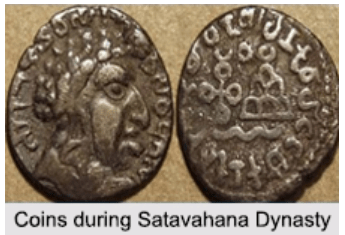
Some important points related to Satavahan coinage are mentioned below:
- The coins of the Satavahanas have been excavated from Deccan, western India, Vidarbha, Western and Eastern Ghats, etc.
- Most of the coins in the Satavahana dynasty were die-struck.
- Cast-coins too existed in the Satavahana empire and there were multiple combinations of techniques that were used to cast coins.
- There were silver, copper, lead and potin coins in the Satavahana empire.
- The portrait coins were mostly in silver and some were in lead too. Dravidian language and Brahmi script were used on portrait coins.
- There were punch-marked coins too that were circulated alongside the Satavahana dynasty.
- The importance of maritime trade was derived from the images of ships present on the Satavahana coins.
- Many Satavahana coins bore the names of ‘Satakarni’ and ‘Pulumavi.’
- Satavahana coins were of different shapes – round, square, rectangular, etc.
- Many symbols have appeared on the Satavahana coins, the major ones of which are:
(i) Chaitya symbol
(ii) Chakra symbol
(iii) Conch Shell symbol
(iv) Lotus symbol
(v) Nandipada symbol
(vi) Ship symbol
(vii) Swastik symbol - Animal motifs were found on the Satavahana coins.
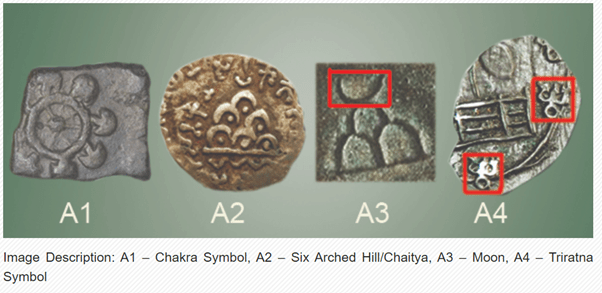
Religious Conditions
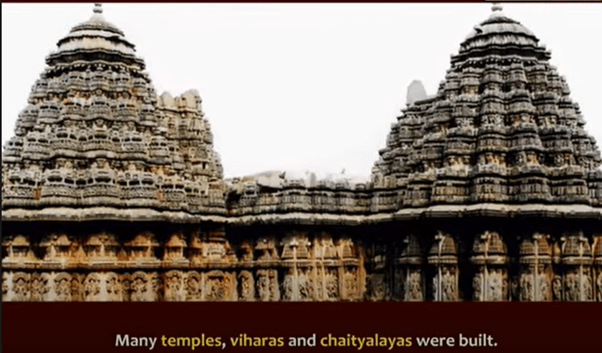
- Most of the Satavahana rulers were staunch followers of the Vedic religion with its ritual and caste system.
- Satakarni II of the Nanaghat record performed a number of Vedic sacrifices including Aswamedhas and Rajasuya. Gautamiputra restored the caste system and protected the Brahmins.
- Adherence to the Vedic creed is also indicated by the name of King Yajna Sri.
- The invocations to various gods like Indra, Sankarshana, Vasudeva, Surya, Varuna etc. show the transition from the Vedic to Puranic pantheon.
- This feature is prominently reflected in Hala's Gatha Saptasati wherein there are references to Pasupali and Gauri, Rudra and Parvati, Lakshmi and Narayana.
- The Aryanized foreigners and mixed castes had solace in the Puranas.
- As PT. Srinivasa lyyangar observed, the two cultsVedic and Agamic had coalesced completely during this period and modern Hinduism was born.
- The Satavahana kings were renowned for their spirit of tolerance They even extended their patronage to the Buddhist ascetics.
- Buddhism commanded greater influence with the womenfolk (especially with the royal ladies) and with the masses.
- It was in fact the heyday of Buddhism in the Deccan.
- The Buddhist monuments at Nasik, Karie, Bhaja, Bedsa, Ajanta, Amaravati.
- Jaggayyapeta and Nagarjunakonda show the Chaitya cult predomment in the South.
- Mehasanghika sects flourished. Acharya Nagarjuna received patronage from the ruler Yajna Sri and from his time Andhra became the stronghold of Mahayanism.
- Due to the patronage and great services of Kharavela of Kalinga, Jainism made considerable progress in the coastal region to the north of river Krishna.
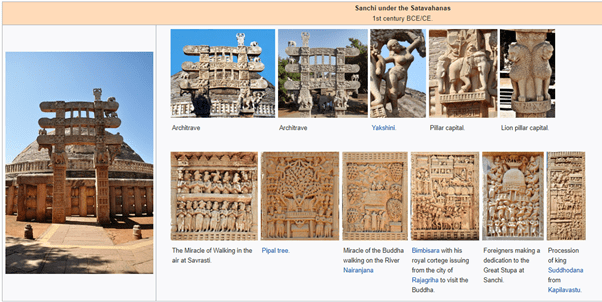
Literature
- As regards the contemporary system of education and literary development, it is but natural that the Aryan, teachers and missionaries brought with them, into the Deccan their own literature and methods of instruction.
- The elaborate sacrifices performed by Satakarni II show how the priests were well-versed in the Vedic literature.
- The Asokan Edicts in the Deccan prove the familiarity of the people with the Brahmi script and the Prakrit language.
- Almost all the records of the Satavahana period are in Prakrit. Instruction in secular and sacred learning was imparted in the asramas of the Brahmins or the Viharas of the Buddhists and the Jains, which received liberal grants from the rulers.
- The craft and trade guilds too might have served the cause of education.
- Among the literary works of outstanding merit produced during this period under the patronage of the Satavahana rulers, mention may be made of the Katantra, the Brihatkatha and the Gatha Sattasai.
- Sarvavarman, probably a minister of Hala composed the Katantra on Sanskrit grammar for the use of the King.
- Gunadhya made over his Brihatkatha in Paisachi Prakrit to the same king Hala.
- Hala himself compiled the Gatha Sattasai, an authology of 700 Prakrit verses of various poets and poetesses. This Sattasai contains many Desi terms.
- An unknown author composed another poem in Prakrit, called Lilavati Parinayam on the marriage of Hala.
- In the later part of the Satavahana period, with the revival of Brahmanical Hinduism, Sanskrit became predominant. The Mahayana Buddhists including Nagarjuna wrote all their works in Sanskrit.
Art and Architecture


- With religion and that too Buddhism as the source of inspiration, the Satavahana period witnessed great building activity.
- The ancient monuments that have been brought to light south of the Vindhyas are almost all post-Asokan and Buddhist in inspiration'.
- They included Stupas, Chaityas, Viharas and Sangharamas discovered both in the Western and in the eastern dominions of the Satavahanas.
- The Bhattiprolu and Amaravati Stupas were the oldest brick-built Stupas in the south.
- The brick-built Chaityagrihas were located at Chejerla and Nagarjunakonda in the east, whereas the rock-cut grihas were in the west at Karle, Nasik, Bhaja and other places.
- The sculptural representations on most of the stupas, of the Jataka tales or the incidents in the life of Buddha and scenes from normal social life, are noteworthy.
- At Amaravati, the well known South Indian centre of Buddhism, a thoroughly indigenous school of sculpture grew up.
- For the conception of the delicate beauty of human form and the technical skill and efficiency to realise that conception and for the wonderful imagination and sense of symmetry in depicting the most subtle human feelings, the Amaravati artist won universal praise.
- With regard to the minor arts, the articles like beads, terracotta figurines, pottery, shell ornaments, precious stones and jewels and coins excavated at Paithan, Maski, Kondapur and other places, indicate their progress during this period. with the extirpation of the Kshaharata family.
- It is solid that he humbled the power and pride of the Kshatriyas and destroyed the Yavanas, Sakas and Pahlavans.
- Gautamiputra Satakarni's dominions included the countries of Asika. Asaka, Mulaka, Surashtra, Kakura, Aparanta, Anupa, Vidarbha, Akara and Avanti, the mountainous regions of Virtdhya, Achavata, Pariyatra. Sahya, Kanhagiri, Siritana, Malaya. Mahendra, Seta and Chokora and extended as far as the seas on either side.
- These details indicate the extent of his empire over the country between Rajasthan and Cuddalore and between the Rishikulya and Vaijayanti.
- Gautamiputra made his horses drink the waters of the three oceans.
- He was uniquely skilled as an archer, absolute as a sovereign and a figure of the heroic mould.
- Though an absolute monarch, Gautamiputra was kind to his subjects and a father to his people.
- He tried to fulfil the duties of the Trivarga-Dharma, Artha and Kama. He shared the sorrows and pleasures of his people. He is described as 'the abode of the Vedas'.
- A pious and orthodox Brahmin, he was meticulous in maintaining caste purity.
- Gautamiputra's son and successor Vasisthiputra Pulomavi (86-11 4 A.D.) could not maintain for long his hold over his vast inheritance. During the last years of his rule, he lost the north-western provinces of the Andhra empire to Chashtana, the founder of the Western Kshatrapa Kardamaka line.
- His successors, Siva Sri and Sivaskanda each ruled for seven years during which period the house of Chashtana expanded its authority upto Cutch in the west by 130 A.D. Chashtana's grandson Rudradaman made his substantial contribution in the growth of the Kardamaka power.
Satavahanas: Material Culture
The material culture of the Deccan under the Satavahanas was a fusion of local elements (Deccan) and northern ingredients.
- The people of the Deccan were fairly acquainted with the use of iron and agriculture. The Satavahanas probably exploited the rich mineral resources of the Deccan such as iron ores from Karimnagar and Warangal and gold from Kolar fields. They mostly issued coins of lead, which is found on the Deccan and also coins of copper and bronze.
- The paddy transplantation was an art well known to the Satavahanas and the area between the Krishna and Godavari, especially at the mouth of the two rivers, formed a great rice bowl. The people of the Deccan also produced cotton. Thus a good portion of the Deccan developed a very advanced rural economy.
- The people of the Deccan learnt the use of coins, burnt bricks, ring wells, etc. through its contacts with the north. There was regular use of fire-baked bricks and use of flat, perforated roof tiles which must have added to the life of the structures. The drains were covered and underground to lead wastewater into soakage pits. The Andhra in the east Deccan included 30 walled towns, besides numerous villages.
Satavahanas: Social Organizations
- The Satavahanas originally seem to have been a tribe of the Deccan. They, however, were so brahmanized that they claimed to be Brahmanas. The most famous Satavahana king Gautamiputra claimed to be a Brahman and thought it his duty to uphold the four-fold varna system.
- The Satavahanas were the first rulers to make land grants to the Brahmans and there are also instances of grants made to Buddhist monks, especially to Mahayana Buddhists.
(i) Nagarjunakonda and Amravati in Andhra Pradesh and Nasik and Junar in Maharashtra became important Buddhist sites under the Satavahanas and their successors, the Ikshvakus. - The artisans and merchants formed an important class of society due to flourishing trade and commerce.
(i) Merchants took pride in naming themselves after the towns to which they belonged.
(ii) Among the artisans, the Gandhikas (perfumers) are mentioned as donors and later the term came to be used for all kinds of shopkeepers. The title ‘Gandhi’ is derived from this ancient term Gandhika. - It was customary for their king to be named after his mother, (Gautamiputra and Vashishthiputra) which indicates that the women occupied an important position in the society.
Satavahana Architecture

 In the Satavahana phase, many temples called chaityas and monasteries called viharas were cut out of the solid rock in the northwestern Deccan or Maharashtra with great precision and patience.
In the Satavahana phase, many temples called chaityas and monasteries called viharas were cut out of the solid rock in the northwestern Deccan or Maharashtra with great precision and patience.
- The Karle chaitya is the most famous in western Deccan.
- The three viharas at Nasik carry inscriptions of Nahapana and Gautamiputra.
- The most important stupas of this period are Amravati and Nagarjunakonda. The Amaravati stupa is full of sculptures that depict the various scenes from the life of the Buddha. The Nagarjunakonda stupa contains Buddhist monuments and also the earliest Brahmanical brick temples.
The Decline of the Satavahanas
- Pulamavi IV is considered the last king of the main Satavahana line.
- He ruled until 225 AD. After his death, the empire fragmented into five smaller kingdoms.
|
1335 videos|1432 docs|834 tests
|
FAQs on Age of Satavahanas - SSC CGL Tier 2 - Study Material, Online Tests, Previous Year
| 1. Who were the Satavahanas? |  |
| 2. What was the political history of the Satavahanas? |  |
| 3. Who was Gautamiputra Satakarni and why is he important? |  |
| 4. What are some interesting facts about the Satavahana dynasty? |  |
| 5. What was the social organization during the Satavahana period? |  |

















